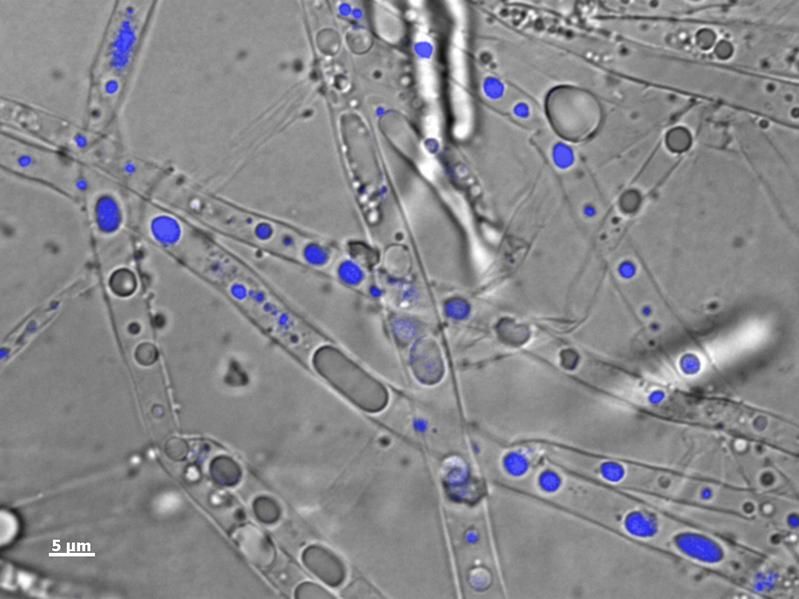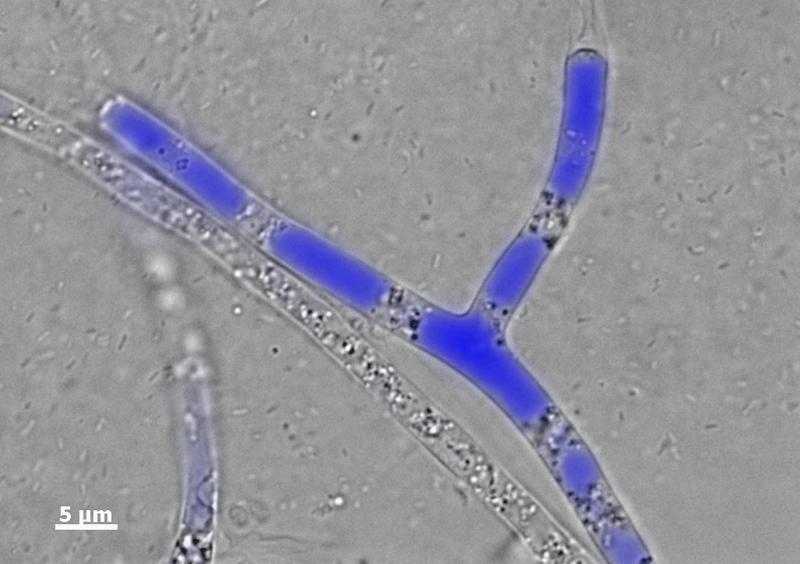Contaminant transport in the fungal pipeline
Advertisement
Fungi are found throughout the soil with giant braiding of fine threads. However, these networks have surprising functions. Only a few years ago researchers from the Helmholtz Centre for Environmental Research (UFZ) discovered that bacteria travel over the fungal threads through the labyrinth of soil pores, much the same as on a highway. Now, together with British colleagues from the University of Lancaster, the UFZ researchers have come upon another phenomenon. Accordingly, the fungal networks also transports contaminants which are otherwise largely immobile in the ground. These living pipelines can therefore contribute to the restoration of impacted areas, write the researchers in the journal Environmental Science & Technology.

Micrograph of the mycelia-forming soil microorganism Pythium ultimum transporting the contaminant phenanthrene in its hyphae: Overlay of a light transmission and a fluorescence micrograph of Pythium ultimum. The hyphae contain phenanthrene-enriched vesicles that fluoresce in blue (bar length: 5 micrometers).
Susan Foß/UFZ

Micrograph of the mycelia-forming soil microorganism Pythium ultimum transporting the contaminant phenanthrene in its hyphae: Overlay of a light transmission and a fluorescence micrograph of Pythium ultimum. The hyphae contain phenanthrene-enriched vesicles that fluoresce in blue (bar length: 5 micrometers).
Susan Foß/UFZ


Some bacteria develop a voracious appetite for contaminants. They nourish themselves from toxic chemicals and at the same time convert these to harmless substances. This makes them valuable allies for the elimination of different forms of environmental pollution. Certain soil microbes, for example, are fully capable of restoring impacted ground by natural means. Theoretically at least. In practice, however, the tiny helpers are frequently pushed to their limits. "The problem is that the contaminants often do not even reach them", explains UFZ researcher Lukas Y. Wick, in charge of the new study.
The bacteria frequently have difficulties with substances which are largely insoluble in water. These include, for example, the polycyclic aromatic hydrocarbons (PAHs) found in crude oil and coal, released in practically all combustion processes. Along well-travelled roads, in the vicinity of airports or old gas works sites, the ground can also be polluted with these compounds. As many PAHs are considered to be carcinogenic, the help of bacteria for the degradation of this pollution would be entirely welcome.
In the complicated labyrinth of water-filled and air-filled pores found throughout the soil, however, bacteria and PAHs rarely come together. This is because the microorganisms are predominantly found in water and in thin liquid films. "The PAHs are virtually insoluble in water, so that they frequently staple themselves to particles of ground in tiny, air-filled pores", which the bacteria are unable to reach, explains Lukas Y. Wick. Between them and their sources of nutrition there are air barriers.
A living network
Nevertheless, there are soil organisms which can effectively overcome such barriers. These include fungi and a group of similar organisms which biologists describe as "pseudo-fungi". Both can grow either in water or in air and are found throughout the soil with a network of fine threads. Each of these so-called hyphae is in fact only a few thousandths of a millimetre thick. Yet, together they form a network of enormous dimensions. One single gram of soil may contain up to 1000 to 10,000 meters of fungal threads. A single braid thereby can extend over several square kilometres. Fungi are therefore in fact the largest living creatures on the Earth today.
That bacteria are fully capable of utilising the infrastructure of this huge neighbour, emerges from an earlier study of Lukas Y. Wick and his colleagues. The fungal braiding appears to be a kind of highway over which the microorganisms can effectively travel and propagate. They move on the surface of the hyphae and, in this way, overcome the air barriers between two water-filled pores without problem.
But what if the fungal network offers good travel possibilities not only for bacteria, but for contaminants as well? Nevertheless, it is known that the transport of nutrients which the fungus requires to survive takes place within the hyphae. Why should this not function, then, with other substances? Together with colleagues from the University of Lancaster, the UFZ researchers have now pursued this question.
For their investigations the researchers employed a pseudo-fungus with the name Pythium ultimum, which is widespread in the soil. This was placed on a central plate with nutrients, proceeding from which it could extend its hyphae to the right and left to two further sources of nourishment. The three nourishment stations were connected by rectangles of nourishment-free material. However, there were several gaps between the nourishment plates and rectangles containing only air. These were intended to simulate the air-filled pores in the ground.
At the edge of a rectangle the UFZ researchers applied a polycyclic aromatic carbohydrate with the name Phenanthrene. They then investigated at regular intervals whether this substance could be detected in other areas of the test path. "The results were astounding", says Lukas Y. Wick. Within a few hours the carbohydrate had migrated from one end of the experimental arrangement to the other – from ten to one hundred times faster than it could have by simple diffusion. Furthermore, it overcame the air gaps with no difficulty, which was not possible over the same path without hyphal networks. "The hyphal networks are therefore not only highways for bacteria, but also pipelines for contaminants", concludes Lukas Wick. "Per hour a single hypha can transport up to 600 times the weight of an individual bacterium".
With a special microscope of the British colleagues it was even possible to observe this transport in detail. Accordingly, the contaminant migrates through the cell wall into the interior of the hyphae. There it is enclosed in tiny bubbles, which Pythium ultimum then actively pumps through its far-reaching network.
Contaminants in motion
In this way the fungal pipeline mobilises not only Phenanthrene, but also other substances virtually insoluble in water and therefore sooner immobile substances. The researchers repeated the experiment with a number of different PAHs, and all were found to be efficiently transported. However, over longer paths the transport of small molecules functioned better than that of large molecules. "Presumably the latter are not taken up as well by the hyphae", in the opinion of Lukas Y. Wick.
In this experiment even the longer paths consisted of only a few centimetres. This may appear to be relatively little, however it could still prove decisive for better contact between the contaminants and their decomposers, as the fungal pipeline effortlessly overcomes the minute air barriers between the water-filled soil pores.
The researchers hope that this effect can be utilised in future for the restoration of impacted ground. The targeted use of fungal networks could accelerate the degradation of PAHs and perhaps also of other substances virtually insoluble in water. "But this may function only when one combines the right fungi and bacteria", explains Lukas Y. Wick. Some types of these organisms are simply not compatible or even mutually inhibit each other. Consequently, the UFZ researchers are now searching for the most suitable partners for their microbial contaminant eliminator team.




























































